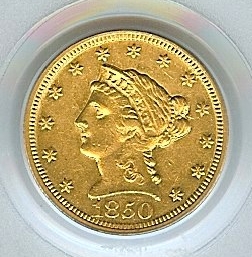1850-C $2.50 AU50 认证号14604211, PCGS号7756
专家评论
Doug Winter
The 1850-C is less rare than its relatively low mintage figure suggests. It is the second most available Charlotte quarter eagle from the 1850s. It is usually seen well worn and is rare in properly graded Uncirculated.The 1850-C quarter eagle is typically found in VF and EF grades. It is scarce in properly graded AU and most at this level are no better than AU50. This is a rare coin in the higher AU grades and very rare in Uncirculated with an estimated four to six examples currently believed to exist.
STRIKE: The strike seen in this date is below average. On many examples, the obverse shows pronounced weakness. The curls around the face are not fully formed and the top of the hair may show little or nor significant detail. The stars are mostly weak at the centers and displayed minimal detail on the radial lines. Some examples are known with good detail at the obverse center. Such coins are quite rare and desirable as they tend to be much more appealing than the typical example of this date, which is characterized by a soft strike. The reverse is always weak on the right leg of the eagle and on both of the claws. The neck feathers are often weak as well.
SURFACES: The 1850-C quarter eagle is nearly impossible to locate without heavily abraded surfaces. Many have deep, detracting marks and these are often seen in the left obverse field. I have seen a considerable number of examples that were struck from clashed dies. The clashmarks are located on the obverse in front of the face and in back of the neck as well as in the field between the hair and the final two stars. A smaller number of 1850-C quarter eagles have clashmarks on the reverse below the left wing and from the beak to the wing. On late die state coins, an “aura” of die rust surrounds the eagle. Some light mint-made roughness is often seen directly above the head of Liberty as well.
LUSTER: Two types of luster are seen on this date. The majority of 1850-C quarter eagles have a frosty texture that is usually better in quality on the obverse than on the reverse. A smaller number have slightly reflective and inferior quality luster.
COLORATION: It is very hard to find an 1850-C quarter eagle that has not been cleaned or dipped. The natural coloration is a distinctive medium green-gold. Some are also seen with a medium to deep coppery orange-gold hue.
EYE APPEAL: Most examples have poor overall eye appeal. This is due to weakly struck details at the centers and heavily abraded surfaces. In addition, the clashmarks described above give many pieces as “busy” appearance that is not appealing. Any 1850-C quarter eagle that is choice and original is very rare.
DIE CHARACTERISTICS: There are four small horizontal die lines jutting out from the denticles above the ninth star. There are also two small vertical die lines out from the denticles near the twelfth star. A fine line extends out from the ball of 5 in the date towards the lower left.
DIE VARIETIES: There are two varieties known.
Variety 1 (formerly Variety 12-G): The 1 in the date is very close to the denticles while the 0 is closer to the denticles than to the bust. The reverse is the same as that seen on the 1849-C. Multiple clashmarks are always seen on this variety.
Variety 2 (formerly Variety 11-H): The obverse is the same as on the last variety. The reverse was used only in 1850. The mintmark is large and the serif is in the feathers. The feathers extend through the mintmark at the upper right. The upper tip of the fraction bar is nearly centered beneath the mintmark. The location of the mintmark is much closer to the fraction bar than to the talon and it is about the same distance from the talon and the 1.
David Akers (1975/88)
Comparable in overall rarity to the 1849-C and equally difficult to obtain in choice condition. Generally underrated as a rarity (as are most quarter eagles) and any specimen better than EF should be considered highly desirable. Always softly struck on the eagle's legs and on the feathers of the arrows.PCGS #
7756
设计师
Christian Gobrecht
边缘
Reeded
直径
18.00 毫米
重量
4.18 克
铸币数量
9148
金属成分
90% Gold, 10% Copper
更高评级数量
56
评级较低的钱币数量
57
地区
The United States of America
价格指南
PCGS 数量报告
拍卖 - PCGS 评级的
拍卖 - NGC 评级的
稀有性和存量估计 了解更多
| 所有评级 | 160 |
| 60或以上 | 7 |
| 65或以上 | 0 |
| 所有评级 | R-7.4 |
| 60或以上 | R-9.6 |
| 65或以上 | R-10.1 |
| 所有评级 | 66 / 147 |
| 60或以上 | 43 / 147 TIE |
| 65或以上 | 1 / 147 |
| 所有评级 | 66 / 147 |
| 60或以上 | 43 / 147 TIE |
| 65或以上 | 1 / 147 |






















